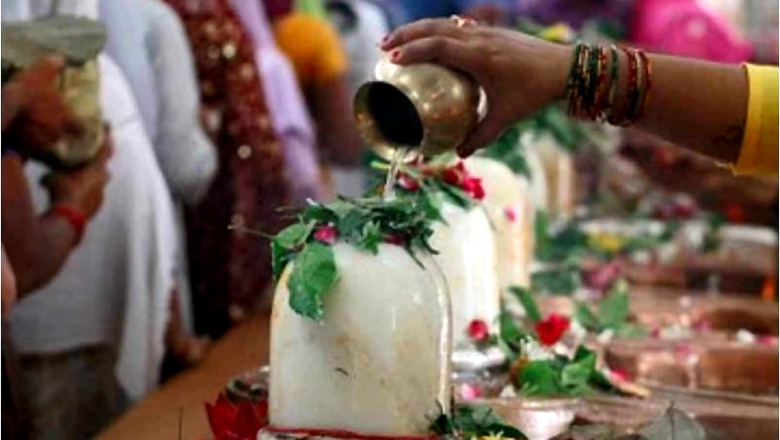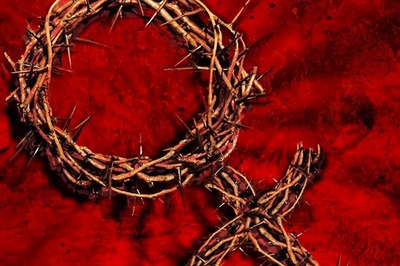
views
Shivling is the metaphorical embodiment of Lord Shiva. It was described by Maharishi Veda Vyasa as a human understanding of the merger of Brahma and Jeev. However, this symbol of divine knowledge, the secrets of the universe, was also misinterpreted, and our perspective of Shiva and Shiva puja, as well as our concept of Shivling, was polluted.
As propagated by Western scholars, Shivling worship originated with the aboriginals and tribals, and Hindus embraced it from there. Our intellectuals supported these false facts about Arya or Sanatani culture’s principal religion. But it was our Rishis, the bearers of our great Vaidik knowledge system, who provided us with the greatest information at a time when the Western world was struggling to establish a civilisation, in the form of Vedas and Upanishads, who were stigmatised as superstitious and morally immoral. They obtained this celestial wisdom via the practice of Brahmacharya, which comprises the practice and study of an in-depth understanding of elements and God. Because they have displayed their grasp of the learned information in the form of Shivling, labelling them as ignorant is unusual and seems plausible.
Lord Shiva has no form and is incomprehensible to us. Ling is defined as a “sign or symbol.” Different signs and logos are used for various companies, commodities, operations, traffic signals, and so on. For example, seeing a lotus sign teaches our thoughts that it is a symbol of the Bharatiya Janata Party (BJP), and seeing a hand is a symbol of the Congress, much as Shivling is a symbol of Lord Shiva. According to Mahabharata Anushasan Parv 14, Brahma’s ling is Kamal, Vishnu’s is Chakra, and Indra’s is Vajra, hence the importance of ling as a symbol can be seen throughout our texts.
The worship of Shivling was not restricted to the Indian subcontinent. The Romans, who introduced Shivling worship to Europe, referred to the ling as ‘Prayapas.’ Shivling sculptures were uncovered during archaeological excavations in Babylon, a metropolis in ancient Mesopotamia. Furthermore, archaeological finds at Harappa-Mohanjodaro and Dholavira at Kutch, the site of many Shivling sculptures, proved the existence of a highly evolved civilisation thousands of years back.
Shivling is divided into three components. The four-sided bottom component stays underneath, while the eight-sided middle section is supported by a pedestal. The upper part, which is revered, is round in shape. The spherical section’s height is one-third of its circumference. Brahma is at the bottom, Vishnu is in the middle, and Shiva is on top. The pedestal is equipped with a tube for draining the water that is placed on top. The Lingam symbolises both Lord Shiva’s creative and destructive power, and its devotees revere it. This is not to argue that people should misinterpret the image of Shiva Lingam.
Hinduism is a modern religion with a scientific foundation. Science is the continuing effort to discover and increase human knowledge of the physical or material universe via investigation and observation. Hinduism, on the other hand, can give answers to particular issues that science cannot. It is unfortunate that some critics have an imagined idea of Shivling as a male organ and treat it with obscenity, yet easily forget how a penis may have formed from the base. Furthermore, since Shiva is considered to have no form, claiming that ling resembles a male organ is nonsensical. Shivling, which is shaped like an egg, represents the ‘Brahmanda’ or the cosmic egg. Shivling represents the whole cosmos, and the cosmos is shown as a cosmic egg. An egg, once again, is an ellipsoid with no beginning or end.
A cursory glance at Shivling’s image shows a pillar with three marks and a disc beneath it, as well as a coiling cobra snake that wraps around the pillar and flashes its fangs above it. The fact behind Danish scientist Niels Bohr’s scientific research suggests that molecules are made up of atoms, which consist of protons, neutrons, and electrons, all of which play a key part in the composition of Shivling. Instead of protons, neutrons, electrons, molecules, and energy, the ancient sages employed words like lingam, Vishnu, Brahma, Shakti (which is further divided into Renuka and Rudrani), and Sarp (snake). The pillar is a column of fire that depicts the three Gods—Brahma, Vishnu, and Maheshwara—according to Sanatana texts, while the disc represents Shakti. Three ridges are carved around the circle of the disc.
According to Maharishi Veda Vyasa, the author of Mahabharata, Shiva is smaller than subatomic particles such as protons, neutrons, and electrons. Simultaneously, he underlines Shiva’s status as greater than anything greater. He is the source of all life’s vitality. Shiva is the originator of all life, both living and non-living. He is eternal. He has neither birth nor death. He goes undetected and unnoticed. He is known as the Soul of the Soul. He lacks empathy, compassion, and excitement. The Shivling has an unusual or inexplicable ability to induce concentration and focus one’s attention. Before travelling to Lanka, Ram and Lakshman fashioned a Shivling at Rameswaram to worship Lord Shiva.
These examples show that God may be imagined and worshipped in whatever manner is most comfortable for the person. It is the divine energy that it represents that is vital, and in Mahabharata, Arjun and Ram & Lakshman in Ramayana worship Shiva as Nirguna Brahman or the formless Supreme Being. Sanatana Hindu Dharma allows people to practise or not to practise, to believe or not to believe, form or formless, genderless or gendered, to worship any form of God/Brahma.
Let us now look at the scientific aspects of Sanatana Hindu Dharma and its God Shiva:
- According to the findings of Danish physicist Niels Bohr, it is essential to have a thorough grasp of the structure of an atom
- An atom is made up of a proton, neutron, and electron. Neutrons would travel in a straight line since they have no charge
- An atom’s nucleus is made up of positively charged protons and neutrally charged neutrons. The nucleus of an atom comprises almost all of its mass. The nucleus is the very dense region of protons and neutrons at the centre of an atom
- Because electrons are negatively charged, they are deflected along a curved path towards the positive plate
- The atom as a whole, on the other hand, is electrically neutral since it contains an equal number of negative electrons and positive protons
- Electrons rapidly revolve around the nucleus in circular paths called energy levels. The energy levels are counted outward from the centre
- Each energy level corresponds to a certain amount of energy
- As long as electrons are circulating at the same energy level and the atoms remain stable, there is no change in energy
- According to the Bohr model, electrons in atoms orbit the nucleus in varied energy orbits. It’s similar to planets circling the sun
- Analysing the Shivling image in the light of the Bohr model reveals the intriguing truth that Brahma created the cosmos. Shivling illustrates the behaviour of protons, electrons, neutrons, and energy in great detail
- That Vishnu is a proton with a positive electrical charge
- Mahesh is a neutron that has no electrical charge
- Brahma is a negative electrically charged electron
- Sakti is the energy symbol. Sakti is a kind of energy field represented by a disc
- Shivling represents the atomic structure. Shiva and Vishnu are both represented by the ling. In Sanskrit, the three lines signify multiples. The atomic structure contains protons and neutrons, which are surrounded by fast spinning electrons
- Sakti is shown as an oval-shaped disc with three ridges engraved around its circumference. She is energy, and she has a significant role in the universe
- In the painting of Vishnu, a lotus is seen blooming from Vishnu’s navel, with Brahma seated above it. Lotus symbolises energy, which has the ability to attract. The stem of the lotus may bend because of its flexibility, symbolising that Brahma goes around Vishnu. This message indicates that electron is attracted to proton because of the opposite electric charge
Shiva, who has no charge, is shown as a neutron. Neutrons may also be detected in the nucleus of an atom. Neutrons are almost the same size as protons; however, they do not have an electric charge. In the nucleus of an atom, neutrons and protons are tightly bound. When an atom’s nucleus has the same number of neutrons as protons, the atom is stable. Similarly, the ancient sages said that Shiva is calm when he is neither disturbed nor split. Shiva remains calm as Shakti takes on the form of Renuka. The energy that creates molecules is represented by its valency, Renuka in Sanskrit. Renuka is the person responsible for the creation of Renu or a chemical. A molecule is composed of two atoms. As a consequence, ancient Hindu sages established the notion of Shakti as Shiva’s wife and as a part of Shiva, dancing around Shiva the whole time. Natural calamities occur when a neutron is broken and separated, suggesting that Shakti changes into a monster known as Rudrani (Kali) performing the destructive dance, marking a natural disaster.
The real generator of molecules is the electron, which symbolises Brahma. According to current physics, a molecule is formed by the exchange of electrons between atoms. As a consequence, science supports the Hindu belief that Brahma created the universe.
Water poured on the Lingam is not considered pavitra, according to science. Shivling is said to be an atom model. Ling emits radiation because it is made of a kind of granite stone. Granite emits radiation and has been shown to have increasing radioactivity, raising concerns about its safety. Granite is assumed to have formed as lava or molten rock that cooled and solidified over hundreds or even millions of years, and it includes naturally occurring radioactive elements including radium, uranium, and thorium. Perhaps this is why ancient Rishis warned against touching the water flowing down on the Lingam — one of the reasons Shiva mandirs are built near bodies of water such as the sea, ponds, rivers, tanks or wells.
Unfortunately, the magnificent work of the ancient Hindu sages is misinterpreted by referring to certain phrases in the Vedas. It is reassuring that recent scientific findings have shown the relevance of the ancient Hindu Rishi’s views. Western intellectuals have previously dismissed these notions as nonsense to maintain their superiority, yet people such as Einstein have recognised the brilliance of Indian Vedic knowledge. It is wiser to respect knowledge, regardless of creed, colour, religion, country or ethnicity, since knowledge is the result of years of someone’s hard effort.
The author is an NIT Surat Research Scholar, and tweets by @gopalgiri_uk. The article is based on the researches of Dr P V Vartak. Views expressed are personal.
Read all the Latest Opinions here



















Comments
0 comment